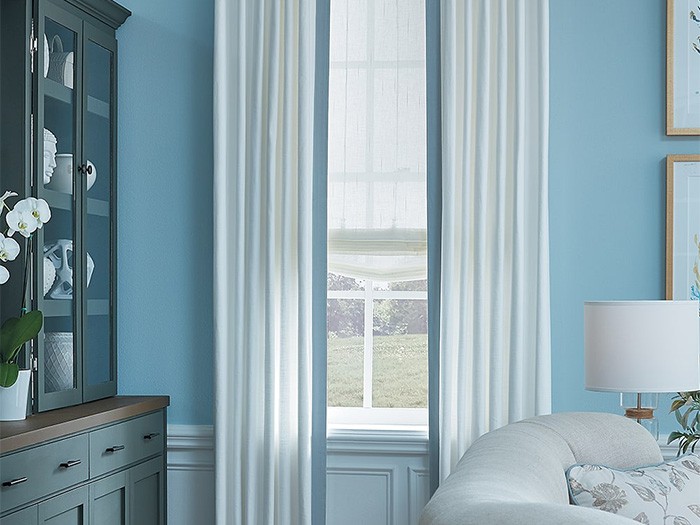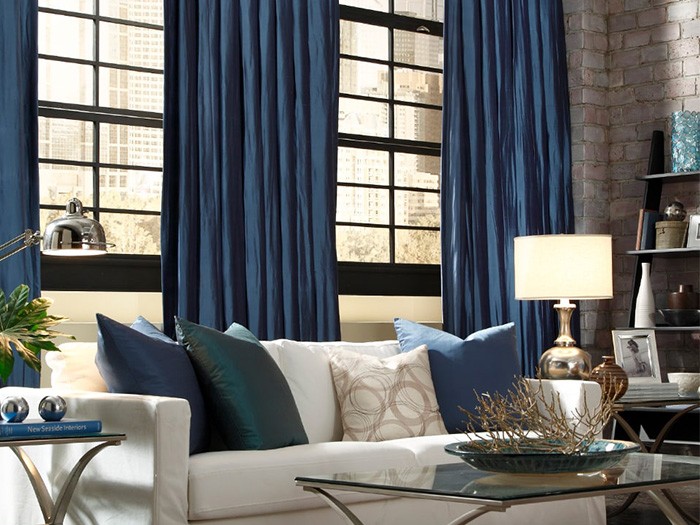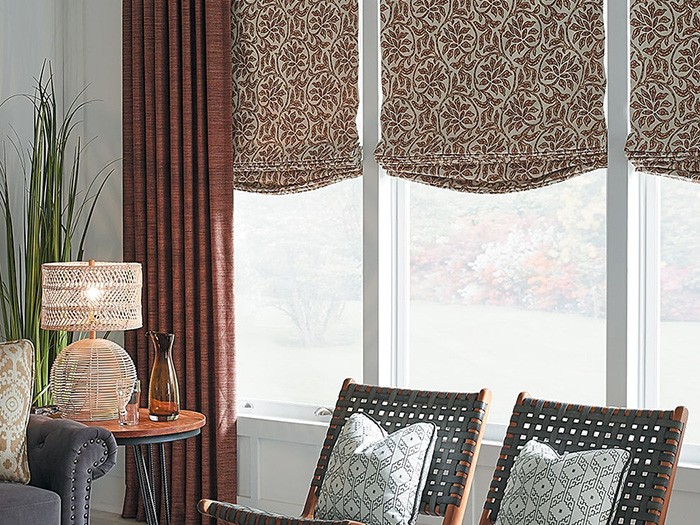Get help finding your perfect window coverings.
Request a consultation today!

Transform light and provide UV protection for your furniture and artwork with innovative, light-diffusing Hunter Douglas sheers and shadings.
Hunter Douglas' cellular honeycomb shades offer superior energy efficiency, helping to keep your home warmer in the winter and cooler in the summer.
Hunter Douglas Roman shades combine the soft look of fabric folds with the operating ease and convenience of a traditional shade, stacking smoothly and evenly when raised.
Simple, classic and elegant, Hunter Douglas roller shades and solar screen shades offer a clean, contemporary look at the window.
Hunter Douglas' Woven Wood shades add warmth and character to your space with materials that pay homage to unique textures found in nature.
The ideal choice for sliding-glass doors or large windows, Hunter Douglas custom vertical blinds are designed in a range of materials, including vinyl, fabric and aluminum.
Rustic. Traditional. Classic. Hunter Douglas provides only the finest wood, faux wood and aluminum horizontal blinds, all available in numerous colors, textures and slat sizes.
Complete your look with Hunter Douglas side panels and drapery. Choose from timeless and on-trend fabrics.
Crafted of lightweight and translucent fabric. For a first-of-its-kind design.
Program your window treatments so that they adjust themselves automatically, creating the perfect room ambiance morning, noon and night.
Program your window treatments so that they adjust themselves automatically, creating the perfect room ambiance morning, noon and night.
Learn more about Hunter Douglas custom window sheers, including our shadings and privacy sheers. Innovative, light-diffusing sheers. Your trusted source for window treatments.
Cellular honeycomb shades from Hunter Douglas. An energy-efficient design that traps air in distinct pockets to help keep your house cool in the summer and warm in the winter.
Custom-made fabric Roman Shades by Hunter Douglas, combining the look of soft folds with the ease and convenience of a shade. Custom-crafted.
The Hunter Douglas roller shades & solar screen shades collections offer excellent light control and a clean, stylish look in a range of fabrics and materials.
For a warm, natural look our Hunter Douglas Woven Wood Shades collection of window treatments transforms sunlight into captivating design statements. Choose yours today.
Find the right custom vertical shades for any room in your home. Search our most popular window shades.
From controlling light to their stylish, sleek look, wood blinds have been a favorite among homeowners for decades.
Find the perfect metal blinds for any room in your home. From controlling light to their stylish, sleek look, metal blinds have been a favorite among homeowners.
Discover Hunter Douglas customized vertical blinds featuring elegant styling and translucency in a large selection of colors, treatments, and textures. Lifetime guarantee.
Hunter Douglas custom window shutters provide superior light control and privacy with classic styles, long-lasting finishes, and exceptional craftsmanship.
Choose from timeless and on-trend fabrics, including lofty textures and alluring jacquards, artisanal embroideries and luminous sheers.
Enjoy the beauty of natural light and make any space more captivating, with the following light-enhancing shades.
Want a darker room for better sleep or optimal movie binging? These shades and drapes help block light at the window.
Live comfortably and save energy with these shades. Designer to keep a room warm in the winter and cool in the summer.
Manage natural light and add privacy with these window treatments that work well for sliding-glass and patio doors.
Create a quieter, more relaxing room with these window treatments, which help absorb sound, reducing exterior noise.
For privacy and natural light, position shades from the top, bottom or both. These shades have this feature available.
Create a unique and beautiful home environment. We can help with beautiful accessories.
Save energy, reduce glare, and protect furniture from fading.
Modernize your bathroom and increase the value of your home.
We offer window treatments for any business or commercial setting.
We offer window treatments for any business or commercial setting.
We offer countertops that are custom-made to fit your space.
We create one-of-a-kind custom bedding designs.
Maximize storage space - custom-made for your home.
Easily change the look of a sofa, arm chair, or bench cushion.
New doors add beauty and value to your home.
Add the perfect finishing touch to your windows.
Choose from a wide selection of styles.
Keep your home warmer in the winter and cooler in the summer with energy-efficient insulation.
Enhance your home's curb-appeal with exterior shutters.
Choose from our large selection of fabric colors, patterns and textures.
We offer a large selection of flooring options for your home.
Create a new look or complement your existing décor with new furniture.
Update your kitchen's look and increase comfort.
We offer a wide selection of lamps and lighting options.
Enjoy the convenience of motorized window coverings.
We offer a wide selection of top-quality paint, primers and stains.
Make your outdoor spaces more comfortable with our outdoor solar shades.
Add color and softness to your window with top treatments.
We offer a wide variety of beautiful wallpaper designs.
Our schedule is flexible, and we can come to your home for a consultation.
We offer quick and professional repairs for your blinds and shades.
We offer professional carpet cleaning services.
We offer financing options for our customers, subject to approved credit.
We offer expert repair and alteration services.
Get a free estimate for your next decorating project.
Our Home Staging service can help you to sell your home faster, at a better price.
We offer a wide range of installation and repair services, expertly done.
We can help you create your dream interior.
We offer expert motorization services for your window coverings.
We offer custom framing for any piece.
We offer re-upholstery services for all furniture styles.
We offer professional upholstery cleaning services.
We offer Video Design Consultations, using video conferencing tools such as FaceTime, Zoom, Skype, and Duo.
We provide professional window cleaning services.
We offer professional window treatment cleaning services.
Our measuring and installation service will ensure an exact fit for your window coverings.
We offer window tinting and window film for your home.
See current and past decorating ideas from our 'Fresh Ideas' Newsletter.
See window covering solutions for privacy and moisture-resistance.
See window covering solutions for privacy and room darkening.
See window covering solutions for light filtering and glare control.
See window covering solutions for a variety of needs and kitchen styles.
See window covering solutions for light filtering and UV protection.
See room darkening window treatments for your media room.
See child-safe window coverings for baby nurseries and kids rooms
See blinds and shades for angled, sloped, and triangle-shaped windows.
See blinds and shades for arched, half-circle or half-moon windows.
See blinds and shades for bay, bow and corner windows.
See shutters, blinds and shades for French Doors.
See blinds and shades for sidelight windows.
See blinds and shades for patio and sliding-glass doors.
See blinds and shades specifically suited for skylights.
See all options for automated blinds and shades.
See our options for blinds and shades that best control light.
See blinds and shades that help save energy at the window.
See blinds and shades for light filtering and UV protection.
See blinds and shades that are safer for children and pets.
 Carole Fabrics Drapery Regal Touch Color: Cream
Carole Fabrics Drapery Regal Touch Color: Cream

 Carole Fabrics Drapery Sheriff Color: Powder
Carole Fabrics Drapery Sheriff Color: Powder

 Carole Fabrics Drapery Aiden Color: Dusty Blue
Carole Fabrics Drapery Aiden Color: Dusty Blue

 Carole Fabrics Side Panels Gear Up Color: Ming
Carole Fabrics Side Panels Gear Up Color: Ming
Get help finding your perfect window coverings.
Request a consultation today!
Thank you for reaching out, we appreciate it! One of our staff members will contact you shortly.
Something went wrong. Please try again later.